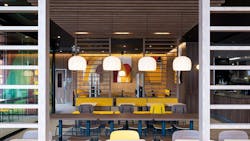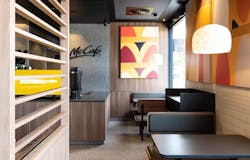Cooper Lighting Solutions creates a 3D printed luminaire for McDonald's
When tasked with finding pendant designs for new store modelings and openings, McDonald’s had a few prerequisites that eliminated the option of an off-the-shelf solution. They required a highly durable, scalable solution with a short lead time; they wanted to own the IP rights; and they wanted it at a competitive cost.
Marc Pochert, senior director of global design integration at McDonald’s Corp., gave more details about the design specifications in an interview with Signify’s Phillips Lighting team, saying, “We want to have a translucent pendant light, semispherical with an embossed pattern which is still translucent but also provides a profile on the top.” The list of wants also included an embossed pattern that would be slightly darker than the base.
Lawrence Fallon, business development manager, Prentalux, Cooper Lighting Solutions worked with McDonald’s to create the perfect design. (Cooper Lighting Solutions was acquired by Signify in early 2020.)
“The pitch that we made,” Fallon told LEDs Magazine, “was more or less, ‘Here’s something that’s sustainable, that matches up with what McDonald’s corporate worldwide is looking for.’ They want something unique; they want something recyclable; they want something that’s good for the environment; and they want something that can be printed or manufactured somewhat locally so that they aren’t shipping things all over the world — and I think that was big because we have multiple 3D-printing facilities around the world. They also liked the fact that we would custom design with them and make a product that could endure the environments of McDonald’s facilities.”
Philips/Signify owns multiple 3D printing facilities in Asia and Europe; Littlestown, Pa., hosts the company’s U.S. 3D printing location, and a second North American location is in the works.
“It allows us to be more sustainable by printing more locally and shipping less; in addition, what we manufacture is much lighter than the standard fixtures in the world. So not only are we shipping shorter distances, but we’re also shipping much lighter materials,” Fallon said.
How customers shape the design
The consultation and design process involves several conversations between the designers and the client, and samples can be produced relatively quickly.
Fallon explained, “We call it dual development. It’s a process where we meet with the client, and we go back and forth several times, and eventually, we get them a print. Typically, we can do that in about eight weeks. Then, we’ll print a sample for them to get their buy-in — so they can feel it, touch it, and understand exactly how it’s going to look and perform.”
For the McDonald’s project, Cooper Lighting had a printed sample product for the client in three months.
“At that point, we usually get some feedback, which could be as simple as ‘Can we try a darker color; could you add a lip to the bottom; could you make it an inch bigger?’ — different things like that, minor details,” he added. “By the time we print a sample for them, we’re confident that we have a good rendering of what they’re looking for, and then it’s just fine-tuning from that point forward.”
According to Fallon, McDonald’s gave their final approval at about six months, so there were about three months of back-and-forth regarding details.
3D printing
The McDonald’s product is made of a polycarbonate material that is custom-built for Philips products. It’s durable, cleanable, and doesn’t yellow with age — all factors the client desired.
“One of the architectural inspirations for McDonald’s was a kind of tent with lines on it, and we were able to come up with something that matched what they were thinking,” Fallon said. “It’s a very unique design, the way that light penetrates the fixture.”
The external surface of the fixture has raised lines and patterns, shaping the light.
"It’s actually thicker where those lines are,” Fallon said. “The whole fixture is done in one print; it doesn’t stop, there are no breaks, the printing just slows down a little, thickens up the polycarbonate, and creates that line so that light doesn’t penetrate. It was something McDonald’s had never seen able to be done on a single-piece fixture. A lot of manufacturers could’ve added paint, or they could’ve added a basket over it or hung something over a glass fixture to create that type of look, but the fact that we were able to print it right into the fixture was very unique.”
In addition, every fixture that Cooper Lighting manufactures and sells in the U.S. is Declare labeled, demonstrating a level of materials transparency to meet corporate or project-level sustainability objectives. “We have a large national account that we’re working with,” Fallon said, “and they have to have Declare on everything they use, and that’s what drew them to us at Cooper.”
HAYDEN BEESON is a writer and editor with over seven years of experience in a variety of industries. Prior to joining Endeavor Business Media as associate editor of Architectural SSL and LEDs Magazine, he was the managing editor of several machine reliability publications.
Follow our LinkedIn page for our latest news updates, contributed articles, and commentary, and our Facebook page for events announcements and more. You can also find us on the X platform.
Hayden Beeson
HAYDEN BEESON is a writer and editor with over seven years of experience in a variety of industries. Prior to joining Endeavor Business Media as associate editor of Architectural SSL and LEDs Magazine, he was the managing editor of several machine reliability publications.






